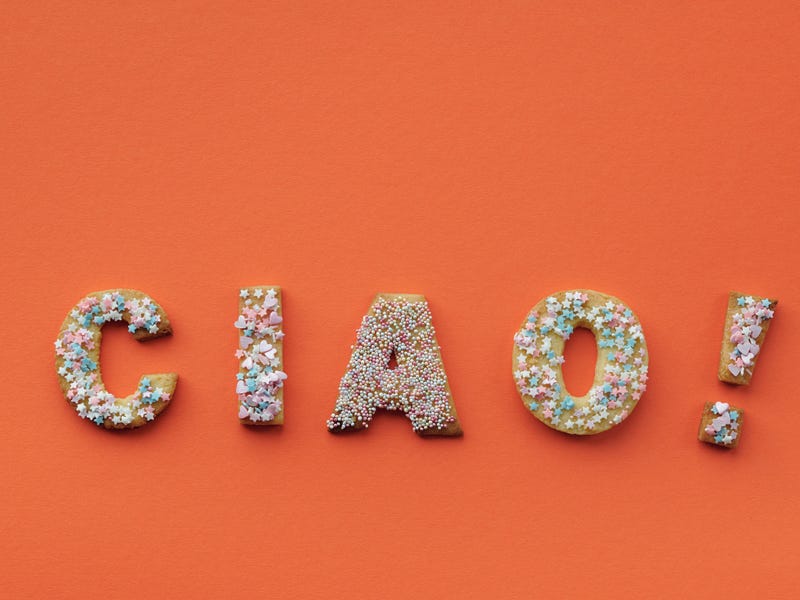
How to ask someone their name & say "my name is" in Italian in 50 useful ways
Author: Jessica Maggi
Introducing yourself in your native language is so easy and simple that you do it naturally, almost automatically. Wouldn’t it be awesome to feel the same in Italian?
Knowing what to say when you meet new people, and how to confidently introduce yourself in different contexts has many advantages. It will help you make a great first impression, break the ice, and set the right tone for the rest of the conversation.
We want to help you get clarity and confidence when introducing yourself and other people in Italian. In this article, we’ll teach you all the words and phrases you need to ask someone their name and introduce yourself gracefully in both business and social situations, even if you’re just starting to learn Italian.
Ready to boost your Italian-speaking skills? Let’s get started!
How to introduce yourself in Italian
Are you stuck when you have to introduce yourself to somebody in Italian? Introductions will always be kind of awkward if you don’t know what to say. Don’t get caught unprepared.
Are you curious to know how to say “My name is” in Italian? The most common way to say “Hello, my name is” in Italian is “Buongiorno, mi chiamo…” and then say your name loudly and clearly. Mumbling it defeats the purpose of the introduction.
Read on for a quick and easy guide on how to start a proper self-introduction in Italian, and get ready for the next time you meet somebody new!
What is your name in Italian
To ask somebody “What’s your name?” in Italian, you can use “Come ti chiami?”. Easy, right? This is considered informal language, and literally translates to, “What do you call yourself?”.
The formal version of this question is “Come si chiama?”, and you should use it with people older than you, and in formal and professional contexts. Be sure to use the correct Italian pronoun.

| English | Italian | IPA | Pronunciation | Context |
|---|---|---|---|---|
| Hello, nice to meet you. What’s your name? | Ciao, piacere di conoscerti. Come ti chiami? | [t͡ʃˈao pjat͡ʃˈere dˈi konˈoʃertɪ kˈome tˈi kjˈamɪ] | cha-oh pee-ah-che-reh dee koh-noh-sher-tee koh-meh tee kee-ah-mee | Informal |
| Hello, nice to meet you. What’s your name? | Salve, molto piacere di conoscerLa. Come si chiama? | [sˈalve mˈolto pjat͡ʃˈere dˈi konoʃˈɛrlˈa kˈome sˈi kjˈama] | sahl-veh mohl-toh pee-ah-che-reh dee koh-noh-sher-lah koh-meh see kee-ah-mah | Formal |
| What’s your name? | Qual è il tuo nome? | [kwˈal ˈɛː ˈiːl tˈuo nˈome] | koo-ahl eh eel too-oh noh-meh | Informal |
| What’s your name? | Qual è il Suo nome? | [kwˈal ˈɛː ˈiːl sˈuo nˈome] | koo-ahl eh eel soo-oh noh-meh | Formal |
| May I know your name? | Posso sapere il tuo nome? | [pˈɔs͡so sapˈere ˈiːl tˈuo nˈome] | poh-soh sah-peh-reh eel too-oh noh-meh | Informal |
| May I know your name? | Posso sapere il Suo nome? | [pˈɔs͡so sapˈere ˈiːl sˈuo nˈome] | poh-soh sah-peh-reh eel soo-oh noh-meh | Formal |
| What’s your last name? | Come ti chiami di cognome? | [kˈome tˈi kjˈamɪ dˈi koɲˈome] | koh-meh tee kee-ah-mee dee kohn-yoh-meh | Informal |
| What’s your last name? | Qual è il Suo cognome? | [kwˈal ˈɛː ˈiːl sˈuo koɲˈome] | koo-ahl eh eel soo-oh kohn-yoh-meh | Formal |
| Your name? | Il tuo nome? | [ˈiːl tˈuo nˈome] | eel too-oh noh-meh | Informal |
| Your name? | Il Suo nome? | [ˈiːl sˈuo nˈome] | eel soo-oh noh-meh | Formal |
My name is in Italian
There are two simple ways to introduce yourself to somebody in Italian. The most natural response to “What’s your name?” is “Mi chiamo…”, which literally translates as, “I call myself…”. You could also simply say “Sono…”(I am…), and then state your name. A typical follow-up question that you should use after saying your name is “E tu?”, and you?
To say what your name is in Italian you can also use other sentence patterns. Take some time to have a look at them, and grow your Italian vocabulary!

| English | Italian | IPA | Pronunciation |
|---|---|---|---|
| Let me introduce myself. I'm Ilaria. And what is your name? | Mi presento, sono Ilaria. E tu come ti chiami? | [mˈi prezˈɛnto sˈono ilˈaria ˈeː tˈu kˈome tˈi kjˈamɪ] | mee preh-sehn-toh soh-noh ee-lah-ree-ah eh too koh-meh tee kee-ah-mee |
| Let me introduce myself. My name is Ilaria. And what is your name? | Mi presento, il mio nome è Ilaria. E tu come ti chiami? | [mˈi prezˈɛnto ˈiːl mˈio nˈome ˈɛː ilˈaria ˈeː tˈu kˈome tˈi kjˈamɪ] | mee preh-sehn-toh eel mee-oh noh-meh eh ee-lah-ree-ah eh too koh-meh tee kee-ah-mee |
| Hello, my name is Ilaria. | Ciao, mi chiamo Ilaria. | [t͡ʃˈao mˈi kjˈamo ilˈaria] | cha-oh mee kee-ah-moh ee-lah-ree-ah |
| Hello, my name is Ilaria. | Ciao, il mio nome è Ilaria. | [t͡ʃˈao ˈiːl mˈio nˈome ˈɛː ilˈaria] | cha-oh eel mee-oh noh-meh eh ee-lah-ree-ah |
| Hello, I'm Ilaria. | Ciao, io sono Ilaria. | [t͡ʃˈao ˈio sˈono ilˈaria] | cha-oh ee-oh soh-noh ee-lah-ree-ah |
| Hello, my name is Ilaria, and yours? | Ciao, mi chiamo Ilaria, e tu? | [t͡ʃˈao mˈi kjˈamo ilˈaria ˈeː tˈu] | cha-oh mee kee-ah-moh ee-lah-ree-ah eh too |
| Hi, nice to meet you! My name is Ilaria. | Ciao, piacere di conoscerti. Sono Ilaria. | [t͡ʃˈao pjat͡ʃˈere dˈi konˈoʃertɪ sˈono ilˈaria] | cha-oh pee-ah-che-reh dee koh-noh-sher-tee soh-noh ee-lah-ree-ah |
| Hi, nice to meet you! My name is Ilaria. | Ciao, piacere di conoscerti. Mi chiamo Ilaria. | [t͡ʃˈao pjat͡ʃˈere dˈi konˈoʃertɪ mˈi kjˈamo ilˈaria] | cha-oh pee-ah-che-reh dee koh-noh-sher-tee mee kee-ah-moh ee-lah-ree-ah |
| Hi, nice to meet you! My name is Ilaria. | Ciao, piacere di conoscerti. Il mio nome è Ilaria. | [t͡ʃˈao pjat͡ʃˈere dˈi konˈoʃertɪ ˈiːl mˈio nˈome ˈɛː ilˈaria] | cha-oh pee-ah-che-reh dee koh-noh-sher-tee eel mee-oh noh-meh eh ee-lah-ree-ah |
| My name is Beatrice, but you can call me Bea. | Mi chiamo Beatrice, ma puoi chiamarmi semplicemente Bea. | [mˈi kjˈamo beatrˈit͡ʃe mˈa pʊˈɔi kjamˈarmɪ semplit͡ʃemˈente bˈɛa] | mee kee-ah-moh beh-ah-tree-che mah puu-oh-ee kee-ah-mahr-mee sehm-plee-che-mehn-teh beh-ah |
| My name is Maria Vittoria, but everyone calls me Mavi. | Mi chiamo Maria Vittoria, ma tutti mi chiamano Mavi. | [mˈi kjˈamo mˌarˈiːa vitːˈɔria mˈa tˈutːɪ mˈi kjˈamano mˈavɪ] | mee kee-ah-moh mah-ree-ah vee-toh-ree-ah mah toot-tee mee kee-ah-mah-noh mah-vee |
| My name is Pierpaolo, but I prefer to be called Paolo. | Mi chiamo Pierpaolo, ma preferisco essere chiamato solo Paolo. | [mˈi kjˈamo pjerpˈaolo mˈa preferˈisko ˈɛs͡sere kjamˈato sˈolo pˈaolo] | mee kee-ah-moh pee-ehr-pah-oh-loh mah preh-phe-rees-koh eh-seh-reh kee-ah-mah-toh soh-loh pah-oh-loh |
How to introduce yourself in response
Quite often, English-speaking Italian learners learn to introduce themselves to somebody in a way that sounds unnatural. We’re coming to the rescue with a list of the most common and natural phrases and expressions to introduce yourself in response in the table below. Take a look!

| English | Italian | IPA | Pronunciation |
|---|---|---|---|
| Nice to meet you, finally. My name is Ilaria. | Piacere di conoscerti, finalmente. Il mio nome è Ilaria. | [pjat͡ʃˈere dˈi konˈoʃertɪ finalmˈente ˈiːl mˈio nˈome ˈɛː ilˈaria] | pee-ah-che-reh dee koh-noh-sher-tee phee-nahl-mehn-teh eel mee-oh noh-meh eh ee-lah-ree-ah |
| I'm Ilaria, nice to meet you, too! I’ve heard nice things about you! | Sono Ilaria, piacere mio! Ho sentito molto parlare di te! | [sˈono ilˈaria pjat͡ʃˈere mˈio ˈɔ sentˈito mˈolto parlˈare dˈi tˈe] | soh-noh ee-lah-ree-ah pee-ah-che-reh mee-oh oh sehn-tee-toh mohl-toh pahr-lah-reh dee teh |
| I'm Ilaria, very pleased to meet you! I’ve heard great things about you! | Sono Ilaria, molto lieta! Ho sentito grandi cose sul tuo conto! | [sˈono ilˈaria mˈolto liˈɛta ˈɔ sentˈito ɡrˈandɪ kˈɔze sˈul tˈuo kˈonto] | soh-noh ee-lah-ree-ah mohl-toh lee-eh-tah oh sehn-tee-toh grahn-dee koh-seh sool too-oh kohn-toh |
| Pleasure to meet you, too. I'm Ilaria. | È un piacere anche per me conoscerti. Sono Ilaria. | [ˈɛː ˈun pjat͡ʃˈere ˈanke pˈer mˈe konˈoʃertɪ sˈono ilˈaria] | eh ooh pee-ah-che-reh ahn-keh per meh koh-noh-sher-tee soh-noh ee-lah-ree-ah |
| I’m so very pleased to meet you, finally! I’m Ilaria. | Molto piacere di conoscerti, finalmente. Io sono Ilaria. | [mˈolto pjat͡ʃˈere dˈi konˈoʃertɪ finalmˈente ˈio sˈono ilˈaria] | mohl-toh pee-ah-che-reh dee koh-noh-sher-tee phee-nahl-mehn-teh ee-oh soh-noh ee-lah-ree-ah |
His/her name is in Italian
Do you avoid introducing people to each other because you don’t know what to say? It can be painfully awkward, we’ve all been there.
Knowing how to introduce other people in both professional and social settings is an important skill that you should not overlook. Everyone can benefit from learning the proper way to make an introduction.
We want you to be 100% ready to go, and feeling confident in your Italian abilities. Check out the table below to find lots of examples!

| English | Italian | IPA | Pronunciation | Context |
|---|---|---|---|---|
| Let me introduce you my brother Davide. | Ti presento mio fratello Davide. | [tˈi prezˈɛnto mˈio fratˈɛllo dˈavide] | tee preh-sehn-toh mee-oh phrah-tehl-loh dah-vee-deh | Informal |
| Let me introduce you my brother Davide. | Le presento mio fratello Davide. | [lˈe prezˈɛnto mˈio fratˈɛllo dˈavide] | leh preh-sehn-toh mee-oh phrah-tehl-loh dah-vee-deh | Formal |
| He is my brother Davide. | Lui è mio fratello Davide. | [lˈui ˈɛː mˈio fratˈɛllo dˈavide] | loo-ee eh mee-oh phrah-tehl-loh dah-vee-deh | All purpose |
| She is my sister Sabrina. | Lei è mia sorella Sabrina. | [lˈɛi ˈɛː mˈia sorˈɛlla sabrˈina] | leh-ee eh mee-ah soh-rehl-lah sah-bree-nah | All purpose |
| This is my brother Davide. | Questo è mio fratello Davide. | [kwˈesto ˈɛː mˈio fratˈɛllo dˈavide] | koo-eh-stoh eh mee-oh phrah-tehl-loh dah-vee-deh | All purpose |
| This is my sister Sabrina. | Questa è mia sorella Sabrina. | [kwˈesta ˈɛː mˈia sorˈɛlla sabrˈina] | koo-eh-stah eh mee-ah soh-rehl-lah sah-bree-nah | All purpose |
| Please allow me to introduce my brother Davide. | Mi permetta di presentarle mio fratello Davide. | [mˈi permˈetːa dˈi prezentˈarle mˈio fratˈɛllo dˈavide] | mee pehr-meht-tah dee preh-sehn-tahr-leh mee-oh phrah-tehl-loh dah-vee-deh | Formal |
| May I introduce my brother Davide? | Posso presentarle mio fratello Davide? | [pˈɔs͡so prezentˈarle mˈio fratˈɛllo dˈavide] | pohs-soh preh-sehn-tahr-leh mee-oh phrah-tehl-loh dah-vee-deh | Formal |
| May I introduce my brother Davide? | Posso presentarti mio fratello Davide? | [pˈɔs͡so prezentˈartɪ mˈio fratˈɛllo dˈavide] | pohs-soh preh-sehn-tahr-tee mee-oh phrah-tehl-loh dah-vee-deh | Informal |
| Have you met before? This is my brother Davide. | Vi conoscete? Questo è mio fratello Davide. | [vˈi konoʃˈete kwˈesto ˈɛː mˈio fratˈɛllo dˈavide] | vee koh-noh-sheh-teh koo-eh-stoh eh mee-oh phrah-tehl-loh dah-vee-deh | All purpose |
| What’s his name? | Come si chiama lui? | [kˈome sˈi kjˈama lˈui] | koh-meh see kee-ah-mah loo-ee | All purpose |
| His name is Davide. | Il suo nome è Davide. | [ˈiːl sˈuo nˈome ˈɛː dˈavide] | eel soo-oh noh-meh eh dah-vee-deh | All purpose |
| What’s her name? | Come si chiama lei? | [kˈome sˈi kjˈama lˈɛi] | koh-meh see kee-ah-mah leh-ee | All purpose |
| Her name is Sabrina. | Il suo nome è Sabrina. | [ˈiːl sˈuo nˈome ˈɛː sabrˈina] | eel soo-oh noh-meh eh sah-bree-nah | All purpose |
How to introduce yourself formally in Italian
Showing the proper respect is crucial with first meetings, so use formal Lei until you develop a closer relationship with the other person. As you surely know, formal Lei is to be used in formal contexts, like a business conference, a job interview, a meeting, a networking event, or a formal gathering, while informal tu is used with peers your age in an informal situation, like a casual party.
If in doubt, use formal Lei and wait for the other person to give you express permission to use informal tu with the expression “Diamoci pure del tu,” which means “Shall we use the informal with each other?”.
In formal situations, it’s best to use first and last names.

| English | Italian | IPA | Pronunciation |
|---|---|---|---|
| Allow me to introduce myself. I’m Giulio Beltramini. Pleasure to meet you. | Mi permetta di presentarmi. Sono Giulio Beltramini. Molto lieto. | [mˈi permˈetːa dˈi prezentˈarmɪ sˈono d͡ʒˈulio beltramˈinɪ mˈolto liˈɛto] | mee pehr-meht-tah dee preh-sehn-tahr-meh soh-noh jee-oo-lee-oh behl-trah-mee-nee mohl-toh lee-eh-toh |
| Pleasure to meet you. My name is Giulio Beltramini. | Lieto di fare la sua conoscenza. Mi chiamo Giulio Beltramini. | [liˈɛto dˈi fˈare lˈa sˈua konoʃˈɛnt͡sa mˈi kjˈamo d͡ʒˈulio beltramˈinɪ] | lee-eh-toh dee phah-reh lah soo-ah koh-noh-shen-tsah mee kee-ah-moh jee-oo-lee-oh behl-trah-mee-nee |
| Pleasure to meet you. I’m Giulio Beltramini. | È un piacere conoscerla. Sono Giulio Beltramini. | [ˈɛː ˈun pjat͡ʃˈere konˈoʃerla sˈono d͡ʒˈulio beltramˈinɪ] | eh ooh pee-ah-che-reh koh-noh-shehr-lah soh-noh jee-oo-lee-oh behl-trah-mee-nee |
| Good morning, my name is Giulio Beltramini. Pleasure to meet you. | Buongiorno, il mio nome è Giulio Beltramini. Molto lieto. | [bʊond͡ʒˈɔrno ˈiːl mˈio nˈome ˈɛː d͡ʒˈulio beltramˈinɪ mˈolto liˈɛto] | boo-ohn-jee-ohr-noh eel mee-oh noh-meh eh jee-oo-lee-oh behl-trah-mee-nee mohl-toh lee-eh-toh |
| How do you do? I'm delighted to meet you. I’m Giulio Beltramini. | Piacere. Molto lieto. Sono Giulio Beltramini. | [pjat͡ʃˈere mˈolto liˈɛto sˈono d͡ʒˈulio beltramˈinɪ] | pee-ah-che-reh mohl-toh lee-eh-toh soh-noh jee-oo-lee-oh behl-trah-mee-nee |
How to end an introduction in Italian
Are you not sure how to end your first conversation with someone you’ve just met? Below you'll find lots of useful, positive statements to help you do this in different contexts. Check them out!

| English | Italian | IPA | Pronunciation | Context |
|---|---|---|---|---|
| It’s been a pleasure. | È stato un piacere. | [ˈɛː stˈato ˈun pjat͡ʃˈere] | eh stah-toh oon pee-ah-che-reh | All purpose |
| It was nice meeting you. | È stato un piacere conoscerti. | [ˈɛː stˈato ˈun pjat͡ʃˈere konˈoʃertɪ] | eh stah-toh oon pee-ah-che-reh koh-noh-sher-tee | Informal |
| It was nice meeting you. | È stato un piacere conoscerla. | [ˈɛː stˈato ˈun pjat͡ʃˈere konˈoʃerla] | eh stah-toh oon pee-ah-che-reh koh-noh-sher-lah | Formal |
| It was nice meeting you. | È stato un piacere fare la tua conoscenza. | [ˈɛː stˈato ˈun pjat͡ʃˈere fˈare lˈa tˈua konoʃˈɛnt͡sa] | eh stah-toh oon pee-ah-che-reh phah-reh lah too-ah koh-noh-shen-tsah | Informal |
| It was nice meeting you. | È stato un piacere fare la Sua conoscenza. | [ˈɛː stˈato ˈun pjat͡ʃˈere fˈare lˈa sˈua konoʃˈɛnt͡sa] | eh stah-toh oon pee-ah-che-reh phah-reh lah soo-ah koh-noh-shen-tsah | Formal |
Download our FREE poster
Learning how to introduce yourself in Italian is definitely the very first skill that you’ll need in order to master that important first impression and to make new Italian friends. We've put together some real life examples to help you on your way. Let's go!
7 etiquette tips for making introductions
We all know that first impressions are important to Italians, but you may not know just how little time you have to actually make one. Well, it takes as little as one-tenth of a second for a person to form an impression of who you are. Really, a blink of the eye is all it takes to make judgments about a person’s likability, trustworthiness, and competence.
We only get one chance to make a great first impression, and this definitely puts pressure on us every time we need to introduce ourselves to somebody new.
The good news is that Italian etiquette rules are coming to the rescue! So, follow our tips to make a good impression when you meet somebody new, and avoid awkward moments.
1. Stand up when you meet someone
If you’re sitting down and someone approaches to meet you, stand up to greet them. Remember to use the appropriate greeting for the occasion and the time of day.
2. Shake hands
Give the person you’re meeting a brief, firm handshake with a welcoming smile and direct eye contact. Etiquette has it that your hand shake is always right hand to right hand, and that you should only shake for 1 to 2 seconds at most.
3. Smile
Smiling is a friendly way to connect with someone you are meeting for the very first time. It makes people feel welcome and immediately puts them at ease.
4. Make proper eye contact
Italians give paramount importance to eye contact. So, smile and maintain eye contact when introducing yourself to someone. In the Bel Paese, good eye contact expresses self-confidence, trust, and a mutual connection between two people.
5. Say something pleasant
It’s polite to say something pleasant after you learn the name of the person you are meeting. As mentioned previously, a simple “Piacere di conoscerti” works like a charm to break the ice.
6. Keep your introductions simple, clear, and short
The best advice I can give you is to keep your introductions short, simple, clear and light, and give the other person room for follow-up questions. Find an appropriate balance between speaking and listening. Share a couple relevant details about yourself, such as where you’re from and what you do for a living, but keep it simple.
7. Introduce younger people to older people first
In both formal and informal contexts, you should always introduce the younger person to the older person first, and junior-ranking professionals to senior-ranking professionals.
È stato un piacere!
And that’s it! You’ve learned how to introduce yourself in Italian like a local in different scenarios.
Knowing how to start a proper self-introduction in different contexts is an important step in your Italian learning journey. Now that you have a nice little base to start, get out there, find someone to talk to, and practice as much as you can until you get the hang of it!
If you enjoyed this article, check out our library of fun and free Italian vocabulary lessons!
Till next time!



